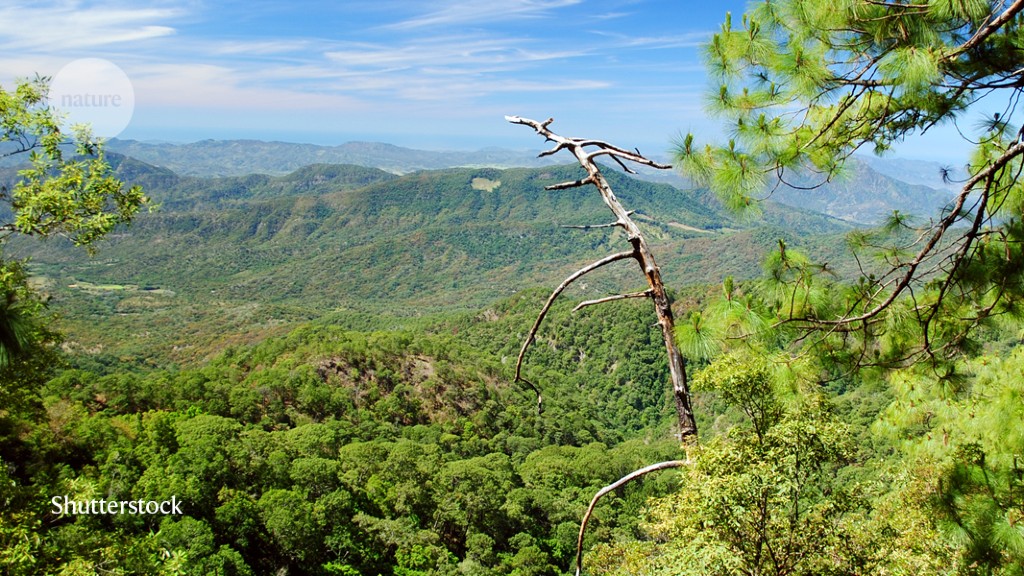The Sierra de Manantlán Biosphere Reserve in Mexico is a source of clean water for city dwellers in nearby towns.Credit: Adriana Margarita Larios Arellano/Shutterstock
Sierra de Manantlán is a 140,000-hectare biosphere reserve in west-central Mexico. It is home to 3,000 species of plants and a forest whose soils and limestone mountains allow purified water to reach the nearby town of Colima.
20 years ago, researchers at the University of Guadalajara in Mexico suggested that Colima should consider paying to use the forest’s clean water and that the money could be used to support residents of the biosphere reserve.
The 30,000 people who lived in the forest were poor and sick. Unemployment was high and there were few schools or medical clinics. But the lack of buildings, mains water, and electricity had an unintended consequence: it kept the forest intact. In return for tending to nature, the researchers argued, the people of the Sierra de Manantlán should be compensated and the funds used for education, health care and job training. Although not a new idea for Mexico, it was rejected by the city’s authorities. The concept that a forest ecosystem has monetary value – and that its custodians could be compensated – has been controversial and often misunderstood.

The value of biodiversity is not equal to its price
However, last week countries took a big step towards allowing authorities to place a value on their environment. At its annual meeting, the United Nations Statistics Commission – whose members are responsible for setting and reviewing standards for official statistics in their countries – established a set of principles for measuring ecosystem health and calculating a monetary value. These principles, known as System of Environmental-Economic Accounting Ecosystem Accounting (SEEA EA), are expected to be adopted by many countries on March 11.
The principles were agreed after a three-year writing and review process involving 100 experts and 500 reviewers from different disciplines and countries. Once adopted, they will provide national statisticians with an internationally agreed set of rules. It will provide a template for payments for ecosystem services – like those once proposed for Colima – and an official benchmark against which the health of ecosystems can be assessed by policymakers and researchers over time.
The decision didn’t go as far as it could have gone. The overwhelming majority of participating countries – led by Brazil, Colombia, India, Mexico and South Africa among others – wanted the new rules to be called a statistical standard. Rich in biodiversity, these countries want to further enhance their natural systems, also in order to be able to compare any ecological losses with potential gains from economic development. The designation of a statistical standard would also have allowed statistical offices to have access to public and international funds to carry out what would be considered a core part of their work and not voluntary or immaterial.
But the United States and a number of European Union countries protested. This was partly because the scoring methodology is still much debated, meaning it’s too early to use “standard” as a label. This setback was unfortunate: participating countries could have adopted the label while creating a system of revision and refinement to ensure the new standard could be further improved. Luckily, the meeting’s participants settled on the next best thing – calling the rules “internationally accepted statistical principles and recommendations”.

Consider the true value of nature as you rebuild the economy after the coronavirus
The objections raised are a reminder that opinions about setting monetary values for nature are deeply entrenched, with compelling arguments on all sides. Some argue that nature is too valuable to be viewed in the same way as a commodity and that it belongs to everyone. Valuation in the economic sense suggests that someone has property rights – but ecosystem services are rarely, if ever, “owned”. The new principles take this into account.
The outcome of the meeting of statisticians shows that there is still a lot of discussion about how to value something that is not bought and sold in the traditional way. But at the same time, this is an active area of research. Many studies were recorded in a landmark report, The Economics of Biodiversity: The Dasgupta Review, published by the UK Treasury last month. The Intergovernmental Science-Policy Platform on Biodiversity and Ecosystem Services is also conducting a review of the assessment design, which will include additional perspectives from the humanities and voices from underrepresented communities such as indigenous peoples.
Debates will continue, but agreement among the world’s statisticians is an important step nonetheless. This means, for example, that those who want to compensate low-income and marginalized communities for protecting nature – like the communities in the Sierra de Manantlán – now have an internationally agreed template to work from. And politicians will have to deal with the heads of the statistical offices if they raise objections. UN chief economist Elliot Harris rightly described the new principles as a game changer. “The economy needs a bailout, but so does nature,” he said. “What we measure, we value, and what we value, we manage.” The momentum to value ecosystem services is unstoppable now, and that’s a good thing.

